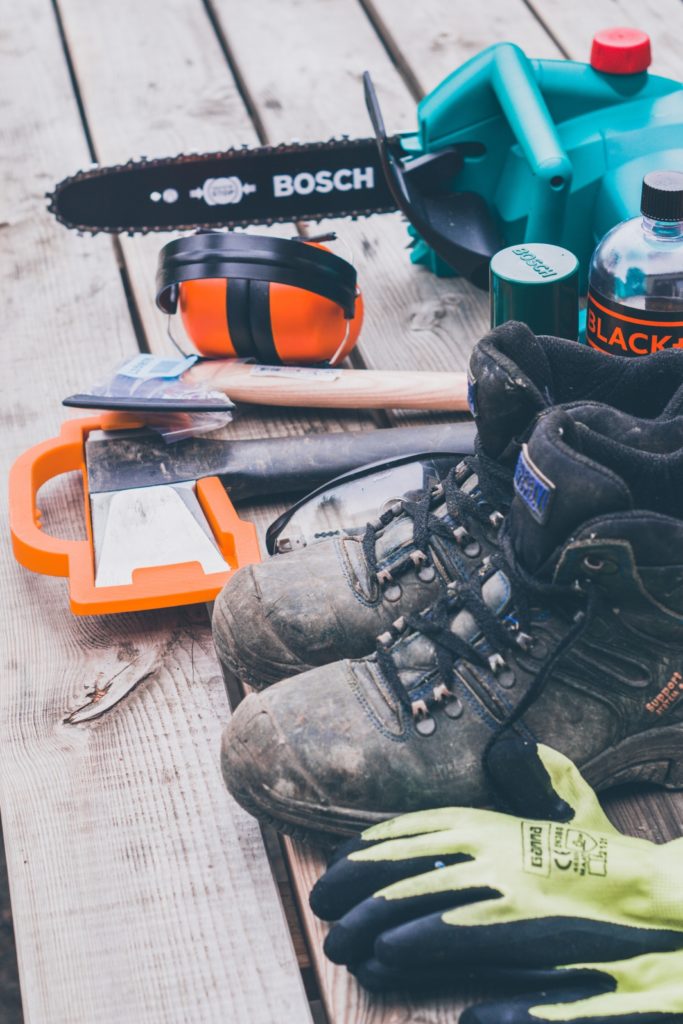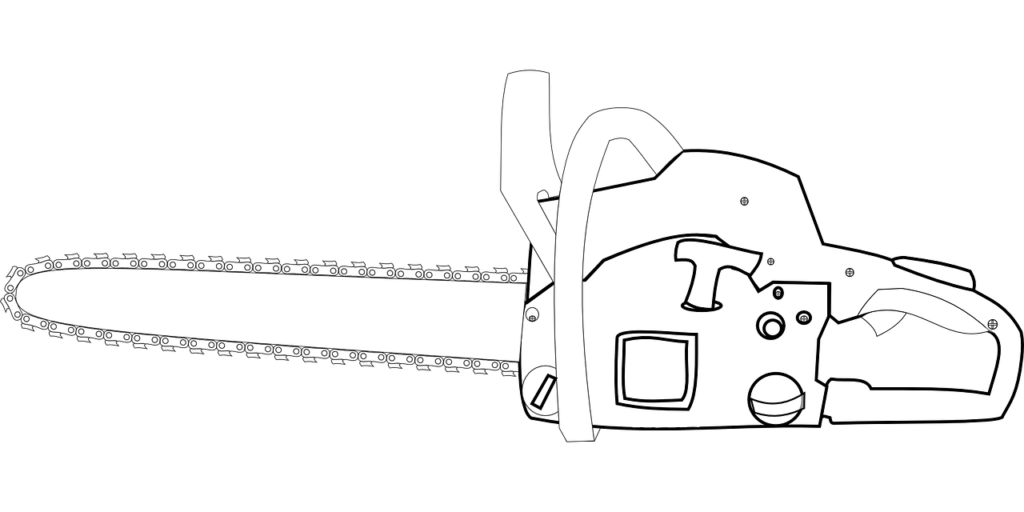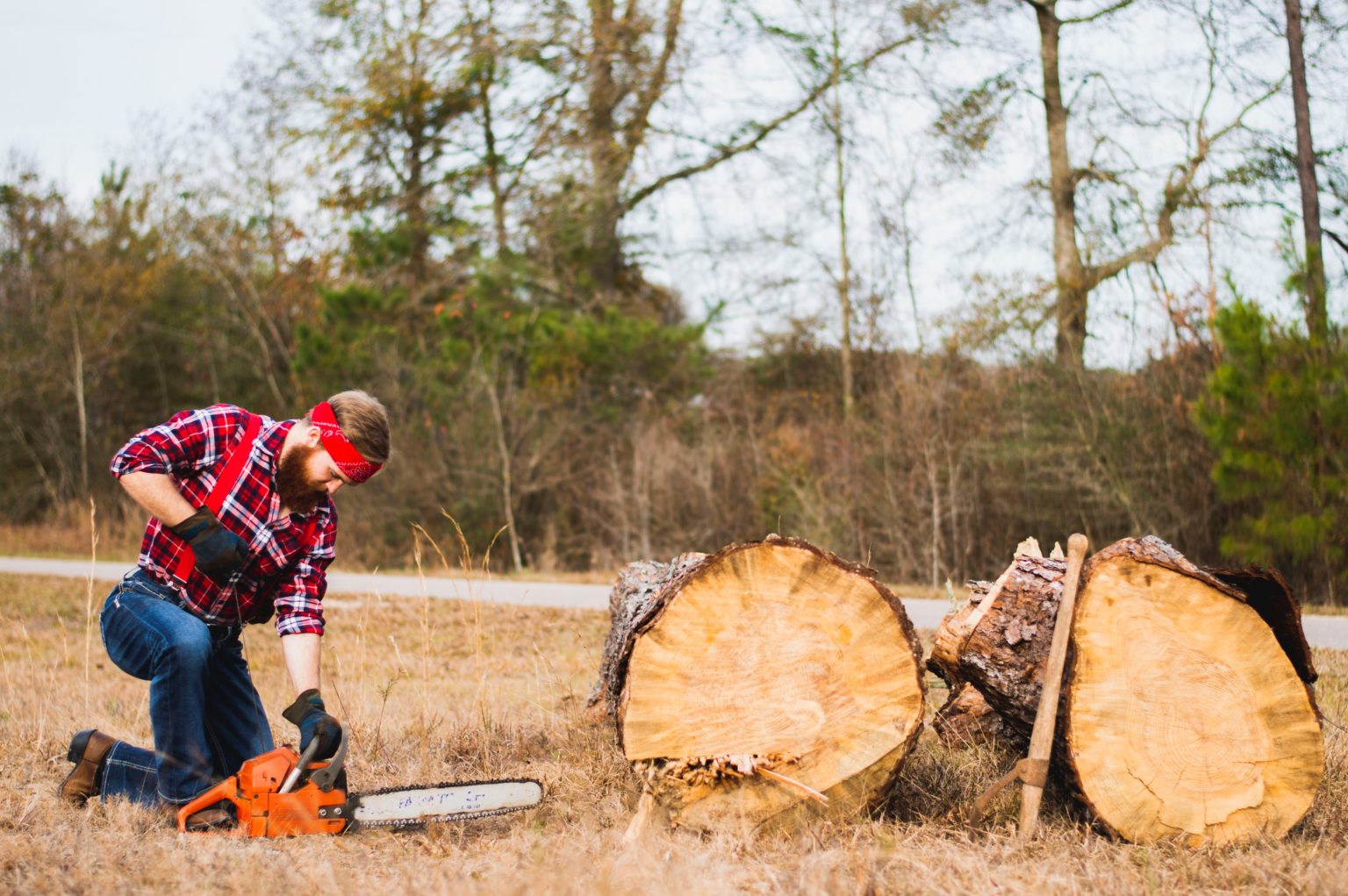You’ve set aside the weekend for backyard projects, and the first item on your task list is to cut away and clear out some dead tree limbs. You grab your chainsaw from the garage and pull the starting cord, but nothing happens. You try again, but your chainsaw won’t start, and the motor won’t run. Why is this happening, and how can you resolve the problem?
Take a look at your chainsaw. Is it powered by gasoline or electricity? When was the last time you had it up and running? How old is it, and how carefully have you maintained it?
Gasoline Chainsaws
Gasoline-powered chainsaws are composed of many interdependent parts. Damaged spark plugs, clogged carburetors, broken springs, bad ignition coils, and other defective components can all prevent your machine from running smoothly. Old fuel, sticky oil, and dirty filters can also impede a clean start.
- High-Strength Steel: Cut trees quickly with our gas chainsaw, thanks to its high-strength steel chain and bar. The 20" bar reduces sawdust splatter, keeping your work area cleaner and safer. This chainsaw is designed to boost your efficiency and comfort on the job.
- Powerful Performance: Featuring a 58CC engine, our gas powered chainsaw cuts through wood smoothly without any stalls. With 3.22HP power, 2.4KW/8500 RPM engine speed, and the max speed reaching up to 12000 RPM, you'll enjoy the ultimate sense of operation brought by strong power.
- Comfortable and Stable: Enjoy a stable and comfortable cutting experience with the built-in shock absorber. It reduces vibrations, extends the life of your gasoline powered chain saw, and lowers maintenance costs, making your work more enjoyable.
- Easy Cutting: Tackle both trimming and felling tasks with ease. The gasoline powered chain saw's cutting diameter reaches 17.91"/455 mm, making it versatile for all your outdoor cutting needs.
- Durable Fuel Tank: Built with a tough outer shell, our top handle chainsaw's fuel tank withstands rough conditions and prevents leaks. With a 0.58 qt/550ml fuel tank and a 0.27 qt/260ml chain oil tank, you'll spend less time refueling and more time cutting.
Create a Safe Work Space

After you consider the most likely culprits, it’s time to troubleshoot. First, create a safe, spacious work area. Set your saw’s chain brake to keep the chain from moving, and keep the machine clear of objects and people. Wear close-fitting clothing to reduce the risk of injuring yourself if you unexpectedly restart the saw. You should also put on gloves, eye guards, steel-toed boots, and any other protective gear you normally use while operating your chainsaw. Find the owner’s manual, and then, grab any tools and supplies you might need for disassembly and maintenance. Compressed air, carburetor cleaner, fuel, oil, and stabilizer are good to have on hand.
- Husqvarna Classic Personal Protective Power Kit includes: one pair of Husqvarna classic chaps (homeowner) (36 to 38 inches, 32-inch inseam), one Husqvarna functional forest helmet, and one pair of Husqvarna classic work gloves (large)
- Ensure Proper Protection: These chainsaw accessories are an easy way to ensure that new chainsaw owners are properly covered with the appropriate personal protective equipment
- Reduce Risk of Injury: 5-layer chainsaw chaps are designed to reduce risk of chainsaw injuries; chainsaw helmet has an HDPE shell with face shield, ear muffs and a sun peak; lightweight chainsaw gloves with synthetic leather palm are great for general use
- Hi-Vis orange makes this chainsaw holder easy to identify on busy job sites and in tree-trimming settings
- Certified Forestry Tools: Chainsaw chaps and helmet meet ASTM F1897, ANSI Z133.1 and OSHA Regulation 1910-26, and hearing protectors have a 24dB(A) NRR rating
Take a Quick Look at Your Saw
If you have an older gasoline-powered chain saw that you have used before, perform a quick check for misaligned, loose, worn, cracked, or missing parts. If the fuel and oil mixture in your chainsaw is more than 30 days old, you’ll want to empty the tank and start fresh. Use high-quality fuel and oil in your machine. In the future, you can stabilize the fuel by purchasing an additive that will prevent it from degrading.
Consider the ambient temperature. In summer, it’s easy to flood the engine. When temperatures are cooler, open the choke to introduce more air into the fuel mix.
If the saw won’t start after these basic troubleshooting measures, then set aside time to thoroughly clean and overhaul your machine.
Take a Look at Your Owner’s Manual

Owner’s manuals are a valuable resource for identifying the parts of your chainsaw, especially if you’re still new to how to use a chainsaw. You can learn how a saw’s components fit together by paying careful attention to the diagrams and instruction sets that describe it. Manuals can help you learn about the idiosyncrasies of your particular machine and help you build confidence when you care for, maintain, and repair your equipment.
Reading the owner’s manual is essential to learning about the specific mechanics of your saw, but most gasoline-powered chainsaws have elements in common that can contribute to difficult starts. Take a look at these failing parts that can impede the easy, reliable operation of your chainsaw.
Blocked Air Filter
A chainsaw engine needs airflow to start and operate. The air filter keeps debris from blowing into the engine. It can easily become clogged with sawdust, so take out the air filter and check it for dirt and debris. Shake or tap it to loosen any stuck particles; then, use compressed air to blow the filter clean from the inside out. Replace the filter if it is sticky, oily, torn, or otherwise irreparably damaged.
- Replace part number: 530-037793 530037793 5300377-93
- For Poulan Craftsman 1900 1950 2025 2050 2075 2150 2175 2250 2350 2375 2450 2550 1634LE 1838 Snapper 1838LE 1900 LE 1950LE 1975 Woodshark 1975LE 2050LE 2050WT Gas Chain Saw.Fits most poulan chainsaw models.
- Air Filter helps eliminate contaminating of dirt,dust and debris from the carburetor and engine. It provides excellent protection against ingested dirt,improves airflow and prolongs engine life by providing clean filtered air while running.
- Package Include:2X Air Filter. Air filter size Length: 2.64"; Width At Narrow End: 2.17"; Width At Wide End:3.35"; Height: 0.71".
- Slother aim to providing you with better products and services. You can contact us first for any problem or concern, your problem will be figured out with our support.
Clogged Carburetor
A clogged carburetor will interfere with proper fuel flow. If debris has fallen into your fuel tank or if its contents have oxidized, there’s a good chance that this degraded material will block the channels that aerate the fuel as it flows through the carburetor. Remove the fuel, take out the carburetor, spray it with carburetor cleaner, and wipe away the buildup. Adjust the carburetor to factory settings as directed in the owner’s manual. If the carburetor is in terrible shape, replace it.
- Carburetor tune-up kit replacement for McCulloch 3200 3205 3210 3516 32cc 35cc 38cc engine chainsaw CS6MHO35UB24RA
- Carburetor Replace Part Number: 9287-310001
- Packing List: 1 x carburetor, 1 x air filter, 2 x gasket, 2 x fuel filter, 1 x primer bulb, 2 x fuel line, 1 x spark plug as pictured
- Please check the product size as shown in the pictures before purchase
Shoddy Spark Plugs
The air-fuel mixture that powers your chainsaw’s combustion engine is ignited by an electric spark. If your spark plug malfunctions, the fuel will not burn. Check to see if the chainsaw’s spark plug is worn, corroded, or dirty. Used spark plugs may also have carbon buildup or burned-out electrodes that prevent them from operating. You can try cleaning the contacts with sandpaper or a steel brush. Test the spark plug by creating an arc of current between it and a piece of metal. Generally speaking, spark plugs are inexpensive. Replace your spark plug if you have any real doubts about its viability.
- 2 pack NGK Standard 6703 Spark Plug
- Genuine NGK Parts
- Includes original packaging and hardware
- Direct replacement auto parts
- Confirm vehicle fitment with Amazon Confirmed Fit
Faulty Ignition Coil
If your new or repaired spark plug isn’t sparking, you may have a faulty ignition coil. Ignition coils provide the voltage that creates the plug’s spark. A damaged spark plug will cause the ignition coil to operate at a higher voltage. The added resistance can cause the coil to overheat and degrade its performance. Over time, damaged ignition coils can stop functioning. You can test the coil with an ignition coil tester or replace it.
- For Chinese 4500 5200 5800 45cc 52cc 58cc Chainsaw.
- Brand: For Chinese Brands CS4500 , CS5200.
- Package Include: 1 x Ignition Coil Module.
Misaligned Recoil Starter
When you pull the starter cord, the action engages a pulley system that sets the engine in motion. Make sure the assembly that coils the starting cord in place is properly aligned and positioned so that the rewind spring stays intact after each pull.
Once all the chainsaw’s parts appear to be in good order, make sure they are properly reassembled, calibrated, and adjusted. Then, try to start your chainsaw again.
Incorrect Fuel to Oil Ratio
All chainsaws have two-cycle engines that burn a mixture of fuel and oil. Fifty parts of fuel to one part of oil is a common ratio, but the proportion can vary. It’s common for chainsaw manufacturers to offer premade fuel mixes to accommodate their machines, but you can also combine gasoline and oil before pouring the mixture into the fuel tank.
- ECO-FRIENDLY LUBRICANT: With ultimate biodegradability, our green, non toxic chainsaw oil is made from North American grown plant oils, so it’s safer for you, safer for your pets and safer for the environment than petroleum based products.
- HIGH PERFORMANCE: Our professional Pro100 Bar & Chain Oil has a high flash point up to 600°F and excellent temperature stability even in extreme conditions. The all season bio-based commercial quality lubricant has a minus 20°F pour point.
- PROFESSIONAL QUALITY: Safer for your employees and better for your equipment, our yard-safe supreme grade chainsaw oil offers outstanding lubricity, superior wear protection, and is high tack to reduce high speed oil sling.
- NON TOXIC FORMULA: Containing no petroleum base oils or metal-based additives, our eco-friendly lubricant is ideal for chainsaws as they are 100% loss applications. This green lube is suitable for use around waterways and other sensitive areas.
- MADE IN THE USA DEWALT Bar & Chain Oil is USDA Certified Bio-based Product
Flooding
Too little fuel will prevent a chainsaw from starting, but too much fuel can swamp the engine. If your chainsaw won’t start after several attempts and you smell gasoline, the engine may be flooded. If the engine is warm, check to make sure the choke is disengaged. To clear a flooded engine, hold the throttle and pull the starter cord a few times. Make sure the spark plug is dry, then try to start the chainsaw.
How to Start a Chainsaw
Cold Start vs. Hot Start
An engine starts “cold” when it has not been operating, in motion, or in use for a while. You need to get the fuel flowing and burning to get the engine running. A “hot” start occurs when you restart the chainsaw after using it a short time ago.
Safety First
Make sure to set the chain brake so that the chain will not rotate around the bar when the engine starts. Next, close the choke to reduce airflow and send concentrated fuel to the engine. If your saw has a decompression valve, press it to reduce pressure in your engine’s combustion chamber so that your engine will be more likely to fire.
Press the primer bulb to send a small amount of fuel and air through your saw’s carburetor to the engine. Repeat this step four to six times. Newer saws have replaced the primer bulb with an air purge bulb that moves excess air out of your fuel lines. Keep in mind that a clogged fuel line can also prevent your chainsaw from running.
Stabilize Your Chainsaw
Always start your saw at ground level. Hold the handlebar, and place your right foot into the boot grip. When the saw is stable, slowly pull the cord. When you feel resistance, pull harder and more quickly. A popping or coughing sound tells you that the engine is firing. Pull the cord again quickly, and repeat the process until the saw starts and runs continuously.
Once your engine has started, open the choke to add air to the fuel mixture and keep the engine running at idle without flooding. Let the saw run long enough to warm up before you begin using it. After a minute or two, release the chain brake and get started.
When you attempt a “hot” start, the engine is still warm, and fuel has already cycled through the carburetor. Reset your chain brake, close the choke, then set it to run or on to open it back up and keep it at a high idle. Press the decompression valve, and pull the starter cord. Once the saw starts, you should be able to set it to a low idle, disengage the chain brake, and use it immediately.
Gasoline-powered chainsaws don’t have automatic electric-start systems, but manufacturers have introduced chainsaws with features that make starting easier. Spring-assisted starters can significantly reduce the force needed to start a saw and make it easier to pull the starter cord. Hot spark devices enhance the spark plug’s ability to create a strong electric current. Capacitor discharge ignition (CDI) systems store an electric charge that helps the plugs fire. Other hot-spark solutions allow the ignition coil to fire at lower RPMs. Some saws have an automatic high idle mechanism that gives the engine the right amount of fuel to start.
Electric Start Chainsaws
Compared to gasoline-powered saws, an electric chainsaw requires minimal effort to start. The starter is cordless, and the ignition is activated by pressing buttons or a switch.
Electric chainsaws can be diagnosed as follows:
Cordless Saws
Most cordless saws are powered by lithium-ion batteries. Make sure your batteries are fully charged, and make sure you have a backup battery on hand.
Corded Saws
Plug your saw into a grounded receptacle that can provide sufficient power to your chainsaw without tripping your circuit breaker. Choose the proper length and gauge of three-prong extension cord to comply with your chainsaw manufacturer’s recommendation.
Trigger and Safety Buttons
By default, the chains on electric saws won’t move until you press the trigger to disengage the chain brake. As you squeeze the trigger switch with your fingers, you must also press the safety button with your thumb. To operate your saw, keep squeezing the trigger switch as you let go of the safety button.
If your electric saw does not respond to these solutions, you may need to replace the motor or the brushes that conduct electricity within it. Brushless motors on corded electric chainsaws are unlikely to cause problems.
Chainsaw Repair
If your saw won’t start after all is said and done, it may be worthwhile to take it to a professional for a closer look. If your saw is still under warranty, check to see if you can take it to an authorized service center for a free repair. A professional can diagnose the problem and provide replacement parts if necessary. They can check for any damage or safety concerns, clear your air filter, and make sure your engine is properly calibrated to rotate the chain at a safe, appropriate rate.
Chainsaws that won’t start are a hassle, but with a little ingenuity and patience, you can resolve the issue and get back to work in no time.







